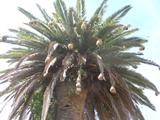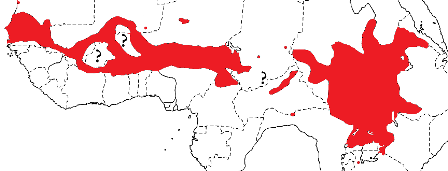Weaver species
Choose different species from drop-down list and press 'Go' button. See Full species list.Little Weaver Ploceus luteolus
IUCN: Least concern Discovery: 032Categories: white eggs, acacias, nectar, Ploceus 5: 'Sitagra', palm,
News items about species
Discovery
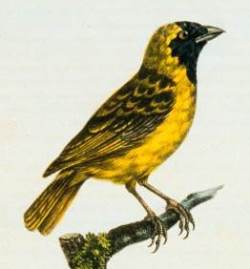
figure from Vieillot 1825 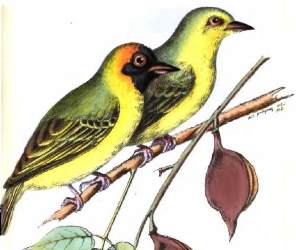
figure from Jardine 1849 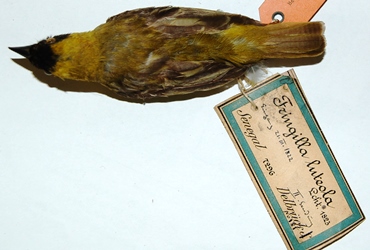
type specimen (ZMB_7296) 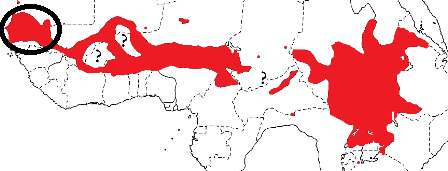
distribution, type locality circled IntroductionThe Little Weaver was formally described by Martin Lichtenstein, a German physician and explorer, who was appointed as director of the Berlin Zoological Museum from 1813.Lichtenstein wrote a brief description in Latin for the Little Weaver, noting its slender bill, and noted its origin as Senegambia. He did not mention the collector, but two type specimens are in the Berlin Museum of Natural History, and the labels list Delbruck, a German collector. Lichtenstein did not list the number of specimens, so there may be more types in other museums. The first illustration of a Little Weaver is a colour painting by Vieillot 1825. The next illustration contains line drawings in Swainson 1838 (not shown here), and then the next published illustration is by Jardine 1849, again in colour but including a female. The Little Weaver had first been described by Vieillot 1823 as Ploceus personatus but all subsequent authors only saw later reprints of Vieillot's work, and thus considered Lichtenstein's name to have priority. It is unclear which publication (Lichtenstein 1823 or Vieillot 1823) appeared in print first. Scientific citationFringilla luteola Lichtenstein 1823 Verz. Doubl., p.23 Senegal.Meaning of namesluteola Latin: luteolus, yellowish, pale yellow (luteus, saffron-yellow).First English nameThe yellowish Ploceole (Reichenbach 1863), first English name used some 40 years after being described. [Initially the first English name was given here as Black-capped Weaver-Finch (Ogilvie-Grant 1902), before finding the current record].Alternate namesAtlas Weaver, Kavirondo Little Weaver, Little Masked Weaver, West African Little Weaver.CollectorDelbruck.Date collectedBefore 1823.Locality collectedSenegal.Type specimensTwo syntypes are in the Berlin Museum. |
The above is based on Weaver Wednesday 2, a weekly series about the discovery of each weaver species.
This species text first appeared as
Weaver Wednesday [149] - Discovery [32]: Little Weaver on 2015-04-21
1. Basic biology


Identification. The Little Weaver Ploceus luteolus is one of the smallest weavers, and is found in the savanna belt from West to western East Africa. The male in breeding plumage has has a black forecrown, face and throat surrounded by bright yellow, without any of the saffron wash typical of larger weavers. It may be separated from the similar Slender-billed Weaver by its dry woodland habitat, and much shorter bill (14 vs 17 cm). It is distinguished from the Lesser Masked Weaver by its brown, not white, eye. The female and non-breeding male are yellowish.
Distribution. The Little Weaver occurs from West Africa across to Ethiopia and Eritrea, and south to Lake Victoria (see map left, based on Birds of Africa). Two races have been proposed previously, but the species is currently treated as monotypic. Habitat. The Little Weaver inhabits savanna woodland with large Acacia trees, open scrubland with small trees, edges of farmland and large gardens, arid thornscrub and red sandy country. It is not gregarious; usually being in pairs, sometimes singly or in small flocks. Food. The Little Weaver feeds on seeds and insects, including small beetles and caterpillars. The Little Weaver forages mainly in acacias and other small trees, working methodically through the foliage. It sometimes feeds on the ground, and may forage with waxbills. Breeding. The Little Weaver is a monogamous, solitary nester and rarely, in colonies. A pair often returns to the same site in successive years. The nest is a globular structure with a short, vertical entrance tube at the side. The nest is densely woven by the male using fine, narrow herb and grass stems, grass blades, palm fronds and small vine tendrils. The nest is lined with grass seedheads and other fine material. The length of the entrance tunnel varies from 50 to 300 mm. The nest is suspended from thorny branches of small trees, often close to occupied wasp nests. Nest construction takes 3-4 days. The male may continue working on the tunnel, even after breeding has ended. The 2-3 eggs are plain white, ovate, and slightly glossy. Nests of the Little Weaver may be taken over by Red-cheeked Cordon-bleus Uraeginthus bengalus. |
The above is based on Weaver Wednesday, a weekly series about weaver species.
This species text first appeared as
Weaver Wednesday [50]: Little Weaver on 2013-05-29
2. Breeding facts
| Pair bond Monogamous Breeding season Jun-Oct in Mauritania and Gambia, May-Nov in Senegal, Aug-Oct in Mali (from Jul in S), Jul-Oct in Ghana, Aug in Togo, Jun-Oct in Burkina Faso, May-Sept in Niger, Jun-Oct in Nigeria, Aug-Nov in DRCongo, May and Aug-Oct in Sudan, Mar-Aug in Ethiopia, Mar-May and Aug-Sept in Uganda, and Feb, Apr and Sept in Kenya Nest site suspended 3-5.5 m above ground from thorny branch Nest building built by male Colony size Often solitary nester, returning to same site in successive years; rarely in colonies Clutch size 2-3 eggs Egg colour plain white Egg size average size of nine eggs 18.4 x 13.1 mm (Nigeria) Incubation incubation by both sexes, period 12 days in captivity Chicks and nestling period chicks fed by both sexes, nestling period in captivity 18-20 days |
Breeding information based on Handbook of the Birds of the World, Vol. 15.
3. Photos of Weaver Nests
 Vm 30397 |  Vm 29650 | 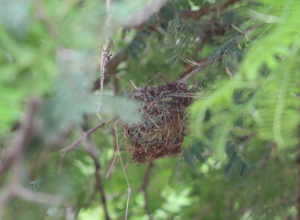 Vm 28593 |  Vm 27738 |  Vm 27561 |  Vm 24528 |
Thumb-nails of most recent PHOWN records - click on one to see its full record
See all PHOWN records for this species here.
PHOWN (Photos of Weaver Nests) provides valuable info on breeding distribution and colony sizes of weavers.
You can contribute by registering and submitting photos at Virtual Museum webpage.
4. Breeding distribution
Google map showing distribution (For species with small ranges you need to zoom in at the correct area to see the range):
yellow blob - range of weaver species; read more about this here.
![]() - PHOWN records with photos
- PHOWN records with photos
![]() - PHOWN records with no photos (Nest Record Cards, other records)
- PHOWN records with no photos (Nest Record Cards, other records)
![]() - Birdpix records
- Birdpix records
![]() - comments on out of range records, or interesting records
- comments on out of range records, or interesting records
![]() - type locality
- type locality
CLICK on the marker on the map to see individual record details.
5. Range changes
Not South African speciesThe above is based on Weaver Wednesday 3, a weekly series about range changes in South African weaver species.
This species text first appeared as
n/a








